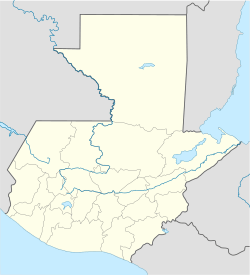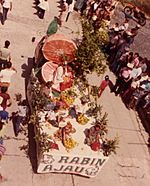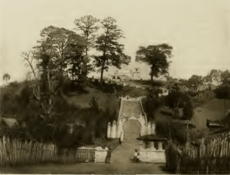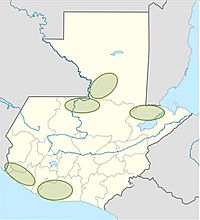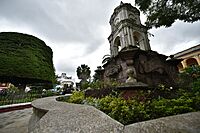Cobán facts for kids
Quick facts for kids
Cobán
Kob'an (Kekchí)
|
|
|---|---|
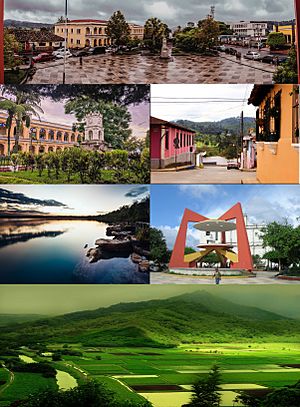
Above, from left to right: Central Park of Cobán, Governing Palace, City Streets, Lachuá Lagoon, Santo Domingo de Guzmán Cathedral and the biodiversity in Cobán.
|
|
| Country | |
| Department | |
| Founded | August 4, 1543 |
| Elevation | 1,320 m (4,330 ft) |
| Population
(2018 census)
|
|
| • Urban | 212,047 |
| Time zone | GMT -6 |
| Climate | Cfb |
Cobán (Kekchí: Kob'an), also known as Santo Domingo de Cobán, is a city in central Guatemala. It is the capital of the Alta Verapaz region. The city is about 219 kilometers (136 miles) away from Guatemala City.
In 2018, Cobán had a population of over 212,000 people. It sits high up, about 1,320 meters (4,331 feet) above sea level. Cobán is famous for growing a lot of coffee.
Contents
Etymology
The name "Cobán" comes from the Q'eqchi' language. It means "between clouds."
History
Early History and Peace Efforts
Long ago, Spanish explorers tried to conquer the native people in this area, but it was very difficult. So, a group of Catholic priests, called the Order of Preachers, decided to try a different approach. They wanted to bring peace to the region, which was known as the "War Zone."
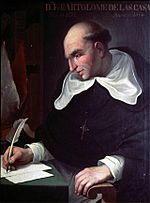
One important priest was Bartolomé de las Casas. He believed that native people should not be forced into labor. In 1537, he made an agreement that if the natives accepted Christianity, they would not be forced to work for the Spanish. This agreement was called the Tezulutlán Capitulations.
Bartolomé de las Casas and other priests taught Christian songs to four native people. These natives then shared the teachings with their communities. One leader, Don Juan, was so impressed that he became a Christian and helped the priests.
In 1543, the city of Cobán was founded. It became a center for the new Catholic teachings. Over time, the area became peaceful. Because of this, the name "War Zone" was changed to "Vera Paz," which means "true peace." This name became official in 1547.
Cobán was even given the special title of "Imperial City" by Charles V, Holy Roman Emperor, a powerful ruler. For a short time, it was known as Ciudad Imperial.
German Settlers and Coffee
In the late 1800s, many German people moved to the Cobán area. They were given land by the Guatemalan presidents. These Germans formed a strong community and started large coffee farms. They helped make Cobán famous for its high-quality coffee.
A British explorer named Alfred Percival Maudslay visited Cobán around 1890. He noted how successful the German coffee growers were. He also mentioned how healthy and happy their children were in the good climate.
The German community built a German club in 1888 and a German school in 1935. By 1930, about 2,000 Germans lived in Cobán. However, during World War II in 1941, the Guatemalan government, led by Jorge Ubico, forced many Germans to leave. This happened because of pressure from the United States. Some people also believe the government wanted to take control of the Germans' land. Many Germans were sent to special camps and later traded for American prisoners of war in Germany.
Even today, you can still see German-style buildings in Cobán. The Germans also built a railway called Ferrocarril Verapaz. This railway connected Cobán to Lake Izabal and helped transport coffee. It ran from 1895 until 1963.
Modern Development
Northern Transverse Strip
Lua error in Module:Location_map at line 420: attempt to index field 'wikibase' (a nil value). In 1970, the government created the Northern Transverse Strip. This was a special area meant for agricultural development. Cobán is part of this important zone.
African Oil Palm
In the 21st century, there has been a big increase in growing African oil palm in Guatemala. This plant is used to make cooking oils. Cobán and nearby areas in Alta Verapaz are now major places for palm oil plantations. Guatemala is trying to become a big exporter of palm oil.
Climate
Cobán has a subtropical climate. This means it has mild temperatures and a good amount of rain throughout the year.
| Climate data for Cobán (1991–2020) | |||||||||||||
|---|---|---|---|---|---|---|---|---|---|---|---|---|---|
| Month | Jan | Feb | Mar | Apr | May | Jun | Jul | Aug | Sep | Oct | Nov | Dec | Year |
| Record high °C (°F) | 34.4 (93.9) |
34.7 (94.5) |
35.4 (95.7) |
36.0 (96.8) |
36.0 (96.8) |
35.0 (95.0) |
32.6 (90.7) |
32.0 (89.6) |
31.0 (87.8) |
34.8 (94.6) |
30.9 (87.6) |
30.8 (87.4) |
36.0 (96.8) |
| Mean daily maximum °C (°F) | 22.3 (72.1) |
23.9 (75.0) |
25.7 (78.3) |
27.8 (82.0) |
27.8 (82.0) |
27.5 (81.5) |
26.5 (79.7) |
26.9 (80.4) |
27.0 (80.6) |
24.9 (76.8) |
22.7 (72.9) |
22.4 (72.3) |
25.4 (77.7) |
| Daily mean °C (°F) | 16.9 (62.4) |
17.8 (64.0) |
19.0 (66.2) |
20.8 (69.4) |
21.2 (70.2) |
21.0 (69.8) |
20.5 (68.9) |
20.4 (68.7) |
20.5 (68.9) |
19.7 (67.5) |
17.9 (64.2) |
17.3 (63.1) |
19.4 (66.9) |
| Mean daily minimum °C (°F) | 10.8 (51.4) |
11.0 (51.8) |
11.3 (52.3) |
12.6 (54.7) |
13.8 (56.8) |
14.6 (58.3) |
14.1 (57.4) |
14.0 (57.2) |
14.4 (57.9) |
13.8 (56.8) |
12.5 (54.5) |
11.5 (52.7) |
12.9 (55.2) |
| Record low °C (°F) | 2.6 (36.7) |
3.8 (38.8) |
4.4 (39.9) |
3.1 (37.6) |
4.9 (40.8) |
6.8 (44.2) |
8.0 (46.4) |
8.6 (47.5) |
6.3 (43.3) |
6.4 (43.5) |
2.2 (36.0) |
3.0 (37.4) |
2.2 (36.0) |
| Average precipitation mm (inches) | 115.4 (4.54) |
88.3 (3.48) |
105.3 (4.15) |
109.6 (4.31) |
185.4 (7.30) |
265.0 (10.43) |
219.1 (8.63) |
238.7 (9.40) |
289.1 (11.38) |
300.3 (11.82) |
232.6 (9.16) |
116.8 (4.60) |
2,265.6 (89.20) |
| Average precipitation days (≥ 1.0 mm) | 12.6 | 9.1 | 8.6 | 8.1 | 14.4 | 19.8 | 20.3 | 19.6 | 21.5 | 19.9 | 15.7 | 12.8 | 182.4 |
| Source: NOAA | |||||||||||||
Culture
Every year in late July, Cobán hosts a big festival for Guatemala's native peoples. It's called La Fiesta Nacional Indígena de Guatemala (National Indigenous Festival of Guatemala). A highlight is a beauty contest where an indigenous woman is crowned "Rabin Ahau," which means "the Daughter of the King" in the Q'eqchi' language.
The main ethnic group here is the Q'eqchi' Mayan. The Q'eqchi' language is widely spoken, especially in the markets where farmers sell their goods. The city's fair starts on the last Sunday in July and lasts for a week.
In May, Cobán holds an international half-marathon. About 4,000 runners come to take part in this popular event. The city's annual religious festival is on August 4, honoring Santo Domingo de Guzman.
Sports
Cobán Imperial Football Club is a well-known soccer team in Guatemala. They won the Guatemala League championship for the first time in 2004. The team plays their home games at the Estadio Verapaz.
Cobán is also known for its history in basketball. The youth basketball leagues in Cobán are considered some of the best in the country.
Tourism
Cobán is surrounded by mountains covered in orchids. The rare Monja blanca orchid is a special symbol of the region. There are several Nature reserves near Cobán, including Las Victorias National Park, San José la Colonia National Park, Laguna Lachuá National Park, and Biotopo Mario Dary Rivera.
Visitors can explore many caves, waterfalls, and forests. These areas are home to the beautiful and rare Quetzal bird. Because of its natural beauty, Cobán is a popular place for eco-tourism.
Other popular places to visit in Cobán include the El Calvario Church, the Dieseldorff coffee plantation, and Plaza Magdalena Shopping Center.
Geographic location
 |
Ixcán, El Quiché municipality |  |
||
| Uspantán, El Quiché municipality | Chisec, San Pedro Carchá and San Juan Chamelco Alta Verapaz municipalities | |||
| San Cristóbal Verapaz, Santa Cruz Verapaz and Tactic, Alta Verapaz municipalities |
See also
 In Spanish: Cobán para niños
In Spanish: Cobán para niños


